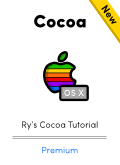You’re reading Ry’s Objective-C Tutorial |
Objective-C Data Types
Objective-C inherits all of the primitive types of C, and defines a few of its own, too. But, applications also require higher-level tools like strings, dictionaries, and dates. The Foundation Framework defines several classes that provide the standard, object-oriented data structures found in typical high-level programming languages.
The Primitives module introduces Objective-C’s native types, and the rest of the above modules cover the fundamental Foundation classes. Below, you’ll find general information about interacting with these classes.
Creating Objects
There are two ways to instantiate objects in Objective-C. First, you have
the standard alloc/init pattern introduced in the Classes module. For example, you can create a new
NSNumber object with the following:
NSNumber*twentySeven=[[NSNumberalloc]initWithInt:27];
But, most of the Foundation Framework classes also provide corresponding factory methods, like so:
NSNumber*twentySeven=[NSNumbernumberWithInt:27];
This allocates a new NSNumber object for you, autoreleases it, and
returns it. Before ARC, this was a
convenient way to create objects, but in modern programs, there is no practical
difference between these two instantiation patterns.
In addition, numbers, strings, arrays, and dictionaries can be created as
literals (e.g., @"Bill"). You’ll see all three notations
throughout the Objective-C literature, as well as in this tutorial.
Comparing Objects
Comparing objects is one of the biggest pitfalls for Objective-C beginners. There are two distinct types of equality comparisons in Objective-C:
-
Pointer comparison uses the
==operator to see if two pointers refer to the same memory address (i.e., the same object). It’s not possible for different objects to compare equal with this kind of comparison. -
Value comparison uses methods like
isEqualToNumber:to see if two objects represent the same value. It is possible for different objects to compare equal with this kind of comparison.
Generally, you’ll want to use the second option for more robust
comparisons. The relevant methods are introduced alongside each data type
(e.g., NSNumber’s Comparing Numbers
section).
 |
Be sure to check out Ry’s Cocoa Tutorial. This brand new guide is a complete walkthrough of Mac App development, and it leverages all of the Objective-C skills that we just discussed. Learn more › |
Mailing List
Sign up for my low-volume mailing list to find out when new content is released. Next up is a comprehensive Swift tutorial planned for late January.
You’ll only receive emails when new tutorials are released, and your contact information will never be shared with third parties. Click here to unsubscribe.